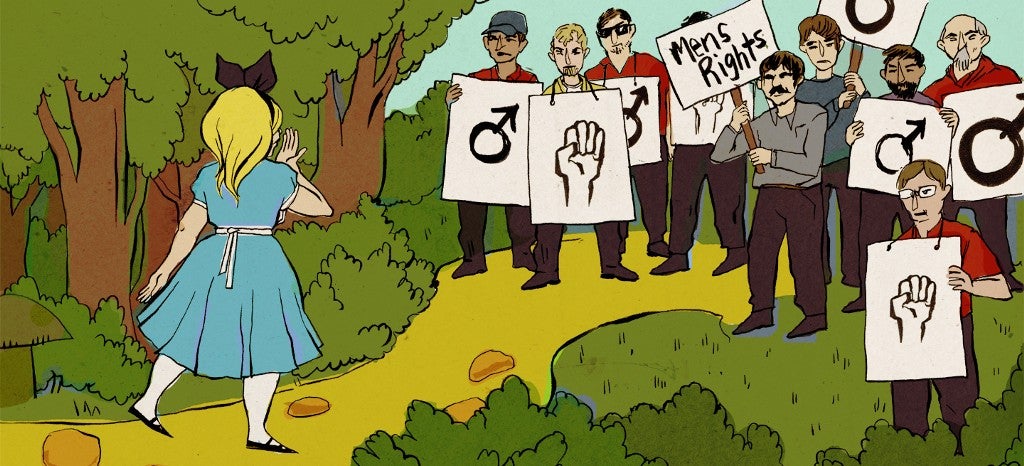This past spring I wrote a story about Edwin Hodge, a man who, before he became a sociologist and feminist, was a men’s rights activist. Hodge was smart, funny and eloquent, and fortunately he had never dabbled in the more radical branches of the movement.
“I Was a Men’s Rights Activist” quickly became one of the most widely read and commented-on pieces at MEL so far. But more importantly, it taught us we could cover MRAs in a way that was thoughtful yet responsible. We had been struggling with how to talk about MRAs without elevating such an extremist, often hateful movement. But the responses showed we had managed to strike the right balance of curiosity and criticism.
That same question — whether and how to talk about MRAs — has surfaced on a global scale these past two weeks in response to The Red Pill, a documentary by Cassie Jaye. Operating under the guise of journalistic balance, Jaye takes the opposite of Hodge’s journey, going from feminist to MRA apologist thanks to her sympathetic encounters with men in the movement.
The movie premiered to little fanfare last month in New York, but MRAs have taken it upon themselves to publicize The Red Pill themselves, organizing screenings in cities across the world: Berkeley, Denver, Sacramento, Providence and Fairfax, Virginia (among others). Their efforts have ignited a “gender war,” according to British tabloid The Telegraph. Last week, a screening in Melbourne, Australia, was canceled after feminists protested it via an online petition. To give MRAs an audience is to endorse their misogyny, argue feminists. To suppress the film is to dismiss men’s issues and engage in the very misandry MRAs want to squelch, proponents counter.

Jaye’s production team gave MEL a screener copy, and, after watching it myself, I can assure you no one needs to see this movie. The Red Pill is bad, and that’s before accounting for its content. It’s long, arduous and boring. The vast majority of the documentary comprises men’s right activists speaking into the camera, droning on about their movement and the burdens of institutionalized misandry.
Worse, The Red Pill is self-indulgent. Interspersed with the interviews are confessionals from Jaye, who gradually warms to MRA dogma. What should be an exploration of the troubling rise of the men’s rights movement (and whether there is anything about it worth saving) turns into a film about Jaye gradually questioning her feminism, and she’s just not compelling enough a personality to hold an audience for two hours. She narrates the film in the robotic monotone of a grade-schooler giving a book report.
But the movie’s greatest sin is that Jaye allows MRAs to promote their ideology uninterrupted and unchallenged. Over time, she becomes increasingly sympathetic to the movement, as she considers some of its less controversial goals, like lowering rates of suicide, unemployment, incarceration and college attrition among men, causes anyone can get behind.
MRAs and feminists diverge in that MRAs blame feminists for men’s problems, while feminists say the problems men face are of their own design. The patriarchy places restrictive, often unattainable expectations and restraints on men and women both; everyone would benefit from its destruction.
But alternative perspectives receive short shrift in the film. The primary moment of dissent comes from Chanty “Big Red” Binx, the type of confrontational feminist that MRAs will instantly dismiss as a feminazi.
MRAs frequently cite anti-male bias in alimony, paternity and custody statutes as evidence of their persecution, for instance. And Jaye cherry-picks stories of women abusing the laws to trick men into impregnating them, bilking them of money and preventing willing men from being fathers. But she neglects to mention these laws reflect millennia of men skipping out on their children, while women can’t easily make that choice.
Jaye interviews a few other feminist intellectuals for a semblance of balance, but they get decidedly less screen time. Ultimately, Jaye takes the red pill herself — the film ends with her saying, “I no longer call myself a feminist.”
There’s always a risk that, in acknowledging a fringe movement, you legitimize it and unintentionally further its cause. But the risk in ignoring MRAs is much greater. Fringe movements only gain traction by relentlessly spreading their message and luring confused, disillusioned minds into their fold. Left unchecked, they fester and grow until their extremist ideology crosses into the mainstream. Trump’s candidacy is a testament to this.
Trying to engage and understand people with such radical viewpoints can seem futile at best, and a maddening journey to the outer reaches of sanity at worst. But it’s necessary, as exhausting and ineffective as it may be at times. As Hodge and Jaye prove, people are capable of profound intellectual change, both for better and worse.
